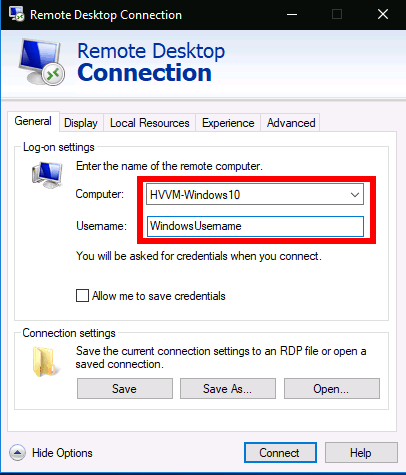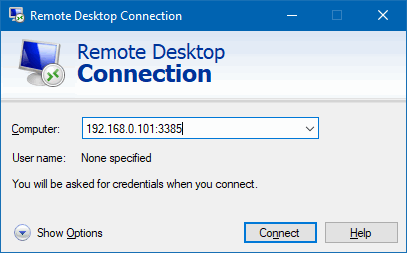- Windows 10 Rdp With Pin
- Windows 10 Remote Desktop Setup
- Windows 10 Remote Desktop Client
- Remote Desktop Using Pin
- Download Remote Desktop Windows 10
Requirements
- Windows 10
- Cloud only, Hybrid, and On-premises only Windows Hello for Business deployments
- Azure AD joined, Hybrid Azure AD joined, and Enterprise joined devices
On your local Windows 10 PC: In the search box on the taskbar, type Remote Desktop Connection, and then select Remote Desktop Connection. In Remote Desktop Connection, type the name of the PC you want to connect to (from Step 1), and then select Connect. On your Windows, Android, or iOS device: Open the Remote Desktop app (available for free. In Windows 8, you can Pin to Taskbar on desktop, Pin to Start screen, add to Quick Launch, assign a keyboard shortcut to it, or move this shortcut to where you like for easy use. When done, you can delete the downloaded.zip file on the desktop if you like, or save it to use again.
Windows Hello for Business supports using a certificate deployed to a Windows Hello for Business container as a supplied credential to establish a remote desktop connection to a server or another device. This functionality is not supported for key trust deployments. This feature takes advantage of the redirected smart card capabilities of the remote desktop protocol. Windows Hello for Business key trust can be used with Windows Defender Remote Credential Guard.
Microsoft continues to investigate supporting using keys trust for supplied credentials in a future release. Ratio entwicklungen driver download for windows 10.


Remote Desktop with Biometrics
Requirements
Windows 10 Rdp With Pin
- Cloud only, Hybrid, and On-premises only Windows Hello for Business deployments
- Azure AD joined, Hybrid Azure AD joined, and Enterprise joined devices
- Biometric enrollments
- Windows 10, version 1809
Users using earlier versions of Windows 10 could remote desktop to using Windows Hello for Business but were limited to the using their PIN as their authentication gesture. Windows 10, version 1809 introduces the ability for users to authenticate to a remote desktop session using their Windows Hello for Business biometric gesture. The feature is on by default, so your users can take advantage of it as soon as they upgrade to Windows 10, version 1809.
How does it work
Windows generates and stores cryptographic keys using a software component called a key storage provider (KSP). Software-based keys are created and stored using the Microsoft Software Key Storage Provider. Smart card keys are created and stored using the Microsoft Smart Card Key Storage Provider. Keys created and protected by Windows Hello for Business are created and stored using the Microsoft Passport Key Storage Provider.
A certificate on a smart card starts with creating an asymmetric key pair using the Microsoft Smart Card KSP. Razer keyboards driver. Windows requests a certificate based on the key pair from your enterprises issuing certificate authority, which returns a certificate that is stored in the user's Personal certificate store. The private key remains on the smart card and the public key is stored with the certificate. Metadata on the certificate (and the key) store the key storage provider used to create the key (remember the certificate contains the public key).
This same concept applies to Windows Hello for Business. Except, the keys are created using the Microsoft Passport KSP and the user's private key remains protected by the device's security module (TPM) and the user's gesture (PIN/biometric). The certificate APIs hide this complexity. When an application uses a certificate, the certificate APIs locate the keys using the saved key storage provider. The key storage providers directs the certificate APIs on which provider they use to find the private key associated with the certificate. This is how Windows knows you have a smart card certificate without the smart card inserted (and prompts you to insert the smart card).
Windows Hello for Business emulates a smart card for application compatibility. Versions of Windows 10 prior to version 1809, would redirect private key access for Windows Hello for Business certificate to use its emulated smart card using the Microsoft Smart Card KSP, which would enable the user to provide their PIN. Windows 10, version 1809 no longer redirects private key access for Windows Hello for Business certificates to the Microsoft Smart Card KSP-- it continues using the Microsoft Passport KSP. The Microsoft Passport KSP enabled Windows 10 to prompt the user for their biometric gesture or PIN.
Compatibility


Users appreciate convenience of biometrics and administrators value the security however, you may experience compatibility issues with your applications and Windows Hello for Business certificates. You can relax knowing a Group Policy setting and a MDM URI exist to help you revert to the previous behavior for those users who need it.
Important
The remote desktop with biometric feature does not work with Dual Enrollment feature or scenarios where the user provides alternative credentials. Microsoft continues to investigate supporting the feature.
Windows 10 Remote Desktop Setup
Related topics
You can not directly pin a RDP connection to the start screen for some reason in Windows 8, even the native Windows 8 Remote Desktop Metro application you can not pin a connection directly to the start screen. To work around this issue you will need to follow these simple steps.
Drivers sfere. Manually create a shortcut on, e.g., the desktop (right-click the desktop, select “New > Shortcut”), and enter the following command:
Windows 10 Remote Desktop Client
Remote Desktop Using Pin

Download Remote Desktop Windows 10
You will be able to pin this shortcut to the start screen or the taskbar, and remote desktop will now directly launch the connection.
